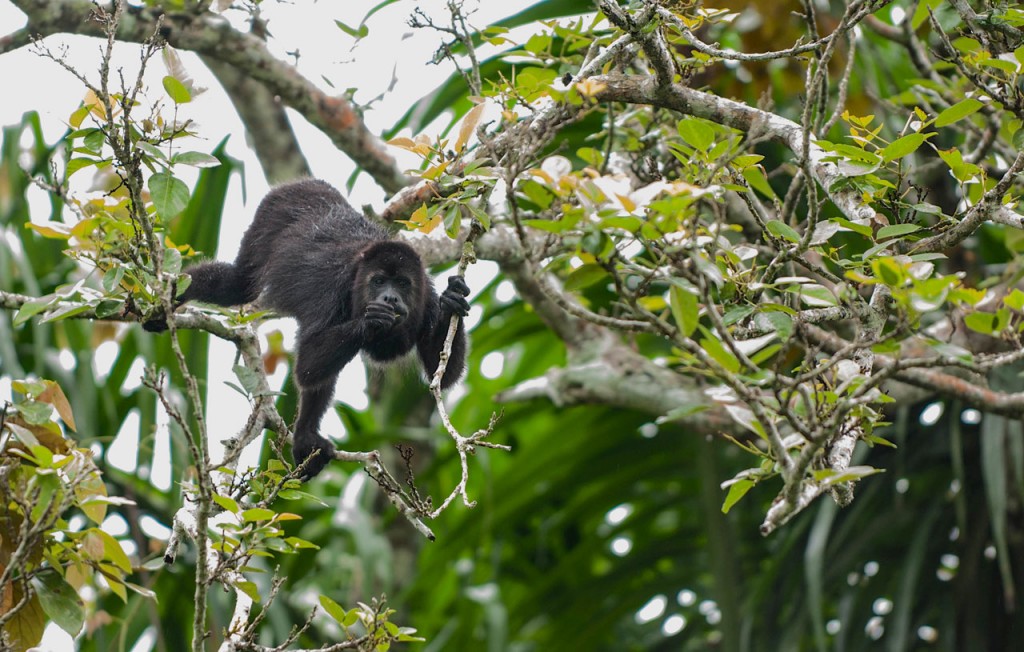
A howler monkey at The Community Baboon Sanctuary. Photo © Lebawit Lily Girma.
The Community Baboon Sanctuary (CBS, tel. 501/245-2009 or 501/245-2007, 8am-5pm daily, US$7) is a nonprofit organization consisting of 220 members in seven local communities who have voluntarily agreed to manage their land in ways that will preserve their beloved “baboon” (the local term for the black howler monkey). Because of community-based efforts to preserve the creature, there are now 3,000 individual monkeys living freely in the forests and buffer zones between people’s farms. Since 1998 the CBS Women’s Conservation Group has overseen the organization and its members, with a female representative from each of the seven villages. More recently, the CBS member landowners received US$15,000 in microgrants to improve their small businesses and communities. CBS feels remote but is less than an hour’s drive from Belize City, making it both a popular day trip and a destination for anyone who’d rather wake up to the throaty roars of Belizean howler monkeys than the bustle of Belize City. Those staying overnight should definitely take advantage of the nighttime trips, such as the 3.5-hour crocodile canoe trip up Mussell Creek and the two-hour night hike into the surrounding forest.There are enough trails, rivers, and guided tours to keep you busy here for a couple of days. All activities are arranged through the CBS Visitors Center (tel. 501/245-2009 or cell tel. 501/622-9624, 8am-5pm daily) in Bermudian Landing; group trips and guides from local hotels are also available. A basic nature walk is included with the entrance fee to the visitors center and museum (feel free to tip your guide), which is small but has very informative displays on a range of topics—from the history of CBS to the local Kriol culture and Belize’s wildlife.There are 1.5-hour and 3-hour canoe tours and a two-hour driving tour of some of the different sanctuary villages. Those staying overnight should definitely take advantage of the nighttime trips, such as the 3.5-hour crocodile canoe trip up Mussell Creek and the two-hour night hike into the surrounding forest. If you’d like to experience the local culture, request a Kriol cultural package (groups of 12 or more, US$15 pp), with food and dance performances.
If you’re lucky, between February and August you might catch a village softball game or cricket match.
One of the six species of howler monkeys in the world, the black howlers, Alouatta caraya, are the largest monkeys in the Americas. Robert Horwich of the University of Wisconsin-Milwaukee was the first zoologist to spend extended time in the howler’s range, which covered southern Mexico, northeast Guatemala, and Belize. The results of his study were disturbing. In Mexico the monkeys were being hunted for food, and their habitat was fast disappearing. Conditions in Guatemala were only slightly better. Here, too, the monkeys were hunted by locals in the forests around Tikal, and as the forest habitat shrank, so too did the number of howler monkeys.
The animal life is thriving—anteaters, armadillos, iguanas, hickatee turtles, deer, coatis, amphibians, reptiles, and about 200 species of birds all live here.In the Belizean village of Bermudian Landing, however, the communities of monkeys were strong and healthy, the forest was intact, and the locals seemed genuinely fond of the noisy creatures. This was definitely the place to start talking about a wildlife reserve. Horwich, with the help of Jon Lyon, a botanist from the State University of New York, began a survey of the village in 1984. After many meetings with the town leaders, excitement grew about the idea of saving the “baboon.” Homeowners agreed to leave the monkey’s food trees—hog plums and sapodillas—and small strips of forest between cleared fields as aerial pathways for the primates, as well as 60 feet of forest along both sides of waterways.
An application was made to World Wildlife Fund USA in 1985 for funds to set up the reserve. Local landowners signed a voluntary management agreement set forth by Horwich and Lyon—and a sanctuary was born.
According to sanctuary manager Fallett Young, who died in 2009, there have been successful relocations of some of the thriving monkey troops around the country, including to the Cockscomb Basin Wildlife Sanctuary, where howlers hadn’t been heard since they were decimated by yellow fever decades ago.
In the case of the Community Baboon Sanctuary, educating people about conservation and encouraging their fondness for nature was more successful than stringent hunting laws. The managers of the sanctuary are villagers who understand their neighbors; much of their time is spent with schoolchildren and adults in the villages concerned. Part of their education includes basic farming and sustained land use techniques that eliminate the constant need to cut forest for new milpas (cornfields).
Another result is the unhindered growth of 100 species of trees, vines, and epiphytes. The animal life is thriving—anteaters, armadillos, iguanas, hickatee turtles, deer, coatis, amphibians, reptiles, and about 200 species of birds all live here.
A lively debate continues among traditional conservationists about allowing people to live within a wildlife preserve. However, Belize’s grassroots conservation is proving that it can succeed.
Excerpted from the Tenth Edition of Moon Belize.